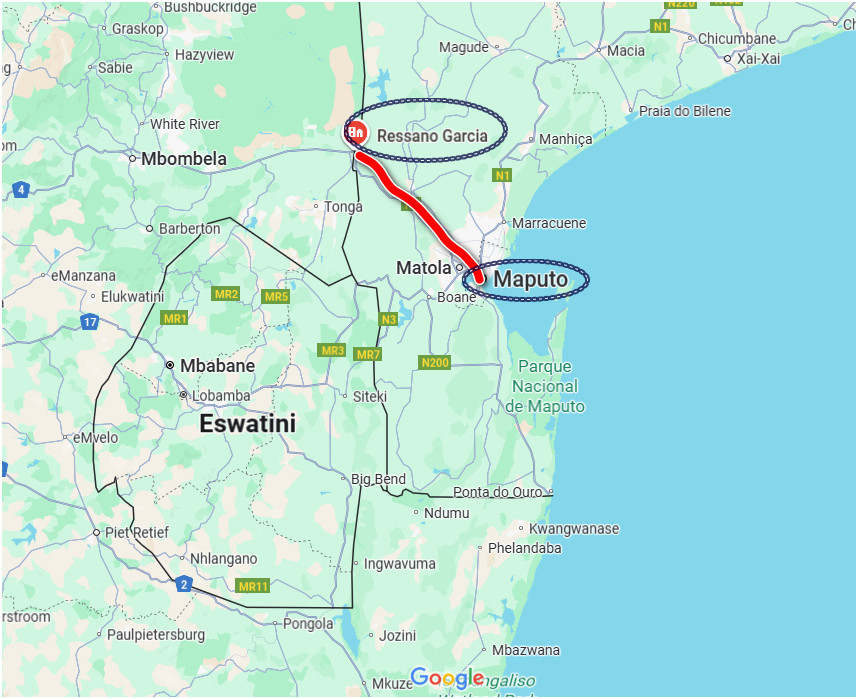
The Maputo Corridor
Connecting South Africa's industrial regions with the Port of Maputo
The Maputo Corridor – A Strategic Gateway for Southern Africa
The Maputo Corridor is one of Southern Africa's most important transport and development arteries. Stretching from Gauteng, South Africa's industrial and economic hub, to the Port of Maputo in Mozambique, it serves as a vital trade route connecting producers, exporters, and markets across the region.
More than just a road and rail network, the corridor is a symbol of regional cooperation between Mozambique, South Africa, and Eswatini. It has become a model for how cross-border partnerships and infrastructure investment can unlock economic potential, stimulate industrial growth, and integrate regional economies.
Today, the Maputo Corridor is more than a line on a map—it is a lifeline for trade and industry. From bulk minerals like coal and chrome to agricultural exports such as citrus and sugar, the corridor facilitates the movement of goods efficiently to international markets. For Mozambique, it represents a key driver of investment and job creation, while for South Africa, it provides a cost-effective gateway to global trade routes.
Historical Background: From Decline to Revival
The story of the Maputo Corridor is closely tied to the political and economic shifts in Southern Africa. Originally developed during the colonial period, the corridor linked the mineral-rich heartland of South Africa with the Port of Maputo—then known as Lourenço Marques. For decades, it was a preferred export route for minerals, agricultural products, and manufactured goods destined for global markets.
However, the region's fortunes changed dramatically in the late 20th century. Mozambique's civil war (1977–1992) devastated infrastructure, disrupted transport routes, and left the corridor underutilized. At the same time, political instability and regional conflict made trade through Maputo difficult, forcing South African exporters to rely more heavily on alternative ports such as Durban and Richards Bay.
The tide turned in the mid-1990s, following the end of apartheid in South Africa and the signing of peace in Mozambique. These milestones opened the door for renewed regional cooperation. In 1996, the governments of Mozambique and South Africa launched the Maputo Development Corridor (MDC)—one of the first large-scale regional development initiatives under the Southern African Development Community (SADC).
The MDC aimed to rehabilitate infrastructure, attract investment, and stimulate economic growth along the corridor. Public-private partnerships (PPPs) played a central role, with projects such as the N4 Toll Road and the modernization of the Port of Maputo laying the foundation for the corridor's resurgence.
What was once a neglected and underutilized trade route has since been transformed into a thriving economic lifeline, positioning the Maputo Corridor as a model of how regional collaboration and investment can drive sustainable growth.
Geographic Scope and Infrastructure: Linking Inland Industry to the Coast
The Maputo Corridor stretches from Gauteng Province in South Africa—the country's economic powerhouse—through Mpumalanga and Eswatini, before crossing into southern Mozambique and terminating at the Port of Maputo. Its geographic positioning makes it one of the most strategic transport routes in the region, serving as the shortest link between the industrial heart of South Africa and the Indian Ocean.
Road Network: The N4 Toll Road
At the heart of the corridor lies the N4 Toll Road, a 600-kilometre highway that connects Pretoria directly to Maputo. Developed through a public-private partnership, the N4 has become a benchmark for infrastructure cooperation in Southern Africa. The modern highway has cut travel times significantly, reduced transport costs, and boosted the competitiveness of goods flowing to and from Mozambique's coastline.
Rail Connections: Reviving the Iron Tracks
Alongside the road network, the corridor also includes an extensive rail system. Operated by Transnet (South Africa) and CFM (Mozambique), the Ressano Garcia rail line links South Africa's mineral and agricultural producers to the Port of Maputo. Investments in rehabilitation and upgrades have steadily increased cargo volumes, particularly bulk commodities like coal, chrome, and magnetite.
Port of Maputo: A Gateway to the World
The Port of Maputo is the beating heart of the corridor. Once underutilized, it has been transformed through joint investment into a modern facility capable of handling millions of tons of cargo annually. Today, the port exports minerals, agricultural goods, and manufactured products not only from Mozambique but also from South Africa and Eswatini. Continuous expansion projects are underway to increase capacity, including new berths, dredging, and advanced handling equipment.
Border Posts and Connectivity
The corridor also depends on efficient cross-border infrastructure. The Lebombo/Ressano Garcia border post is the busiest gateway on the corridor, handling thousands of trucks each month. While congestion remains a challenge, ongoing reforms aim to streamline customs procedures and reduce delays. Improved digital systems and harmonized regulations are expected to make the crossing smoother for traders.
Together, these elements—road, rail, port, and border infrastructure—form a robust logistics chain that underpins the success of the Maputo Corridor. By linking inland industries to global markets, the corridor has cemented its role as a critical driver of regional integration and economic growth.
Economic Significance: Driving Trade and Regional Growth
The Maputo Corridor is more than just a transport route—it is a catalyst for economic development across Southern Africa. By connecting South Africa's industrial regions with the Port of Maputo, the corridor facilitates trade, attracts investment, and supports industrial growth in both Mozambique and its neighboring countries.
Boosting Trade and Exports
One of the corridor's most significant impacts is in trade facilitation. Minerals like coal, chrome, and magnetite, as well as agricultural products such as citrus, sugar, and timber, are transported efficiently along the corridor. The proximity to the port allows producers in South Africa and Eswatini to access international markets at lower costs, increasing competitiveness and profitability.
Supporting Industrial Growth in Mozambique
The corridor has also been instrumental in supporting industrial development within Mozambique. The Beluluane Industrial Park (BIP) and facilities like the Mozal Aluminium Smelter rely on the corridor for the transport of raw materials and finished goods. Reliable infrastructure has enabled these industrial hubs to expand, creating jobs and stimulating economic activity in the Maputo region.
Regional Integration and Economic Cooperation
Beyond trade and industry, the corridor strengthens regional economic integration. By linking Mozambique, South Africa, and Eswatini, it fosters cross-border collaboration and aligns with the objectives of the Southern African Development Community (SADC). Efficient movement of goods and people along the corridor promotes economic interdependence, supporting growth across national boundaries.
In essence, the Maputo Corridor is a key economic artery that not only facilitates exports but also stimulates industrialization, attracts investment, and promotes regional cooperation—making it a cornerstone of Southern Africa's development strategy.
Challenges and Constraints: Navigating Obstacles Along the Corridor
While the Maputo Corridor offers immense opportunities, several challenges and constraints must be addressed to ensure its full potential is realized. Understanding these factors is crucial for investors, policymakers, and businesses operating in the region.
Border Congestion and Customs Delays
The Lebombo/Ressano Garcia border post, the busiest crossing along the corridor, often experiences congestion, especially during peak trade periods. Delays in customs clearance and inspections can slow the movement of goods, increase transport costs, and reduce efficiency for exporters and importers alike.
Infrastructure Maintenance and Capacity Limits
Although the corridor has modernized roads, rail, and port facilities, aging infrastructure and limited capacity remain issues in certain areas. Maintenance backlogs, insufficient railway wagons, and port bottlenecks can hinder the smooth flow of goods and constrain growth. Continuous investment and upgrades are necessary to meet rising trade volumes.
Security Concerns
Certain sections of the corridor, particularly in remote areas, are prone to theft and crime targeting trucks and cargo. Security risks not only threaten shipments but also increase insurance costs, requiring comprehensive measures to protect investments and ensure safe transit.
Crime and Security Challenges at Ressano Garcia, Mozambique
Ressano Garcia, a major border crossing between Mozambique and South Africa, faces serious security challenges, particularly at night. The area, including a nearby cemetery, is notorious for robberies targeting truck drivers, travelers, and local residents.
Key points:
-
Truck drivers transporting valuable goods often face theft of merchandise, money, fuel, and vehicle parts, especially after long waits at border crossings.
-
Local residents and small business operators, including women working in currency exchange, are frequently victims of robbery and harassment.
-
Criminal activity is often organized, with groups of young individuals hiding near the cemetery and striking around 18:00–19:00.
-
The police presence is limited, and patrols are infrequent, leaving travelers and locals vulnerable.
-
Security concerns affect both commerce and personal safety, creating delays, losses, and heightened anxiety for those using the border route.
Overall, Ressano Garcia is a strategically important but high-risk area, highlighting the need for stronger law enforcement and community safety measures to protect both trade and residents.
Smuggling and Customs Control at Ressano Garcia
The Ressano Garcia border is Mozambique's busiest entry point, closely monitored by customs to prevent smuggling of poultry, alcohol, cigarettes, and other goods. Trucks and vehicles are inspected using scanners, lasers, and advanced technology at key checkpoints like KM-4.
Smuggling is often organized, with networks planning entry times to evade taxes. Confiscations highlight the revenue loss from undeclared goods, which could fund infrastructure projects.
Customs also monitor tourist vehicles and small imports, but processing delays can cause trucks to wait hours or days. Efforts are underway to streamline inspections and integrate road and rail transport.
Ressano Garcia remains a critical checkpoint protecting Mozambique's revenue while facilitating legitimate trade.
Regulatory and Policy Alignment
The corridor spans three countries—Mozambique, South Africa, and Eswatini—each with its own regulatory framework. Differences in customs procedures, transport regulations, and licensing can complicate operations, requiring careful coordination and harmonization to facilitate smooth cross-border trade.
Background Information:
Disruptions caused by protests and congestion
Maputo Corridor Explores Alternatives to Ressano Garcia Border
The Maputo Logistics Corridor is seeking alternative border crossings to ease the pressure on Ressano Garcia, one of Mozambique's main revenue-generating borders. Disruptions caused by protests and congestion have highlighted the need to diversify routes to maintain smooth cargo flow in southern Mozambique.
Key points:
-
Alternative borders suggested include Goba, Ponta Douro, and Namacha. Historically, these crossings were more active but became underused after traffic concentrated at Ressano Garcia.
-
Logistics expert Clávio Maquáa emphasizes the urgency of operationalizing Ponta Douro to support trade and regional cooperation with South Africa.
-
President Filipe Nyusi's diplomatic efforts with South Africa include a $200 million investment to strengthen the Maputo Corridor, aiming to improve infrastructure and solutions for cross-border trade.
-
The corridor has already invested $40 million in logistics infrastructure, including an international terminal with customs, inspection, and clearance facilities to streamline cargo movement.
-
Diversifying border crossings is seen as critical to alleviate congestion, improve efficiency, and secure trade revenue while supporting regional economic integration.
Southern Mozambique Railways: Goba, Limpopo & Ressano Garcia Lines
Mozambique's southern railway system spans key corridors connecting Maputo with Eswatini, Zimbabwe, and South Africa. It includes three major lines:
-
Goba Line (467 km): Connects Maputo to Matsifa in Eswatini, transporting 780,000 tons of cargo and 3 million passengers annually. Operational since 1912, it was modernized in 2022 with border removal to streamline trade.
-
Limpopo Line (900 km): Links Maputo to Samabula, Zimbabwe. Built along the Incomati and Limpopo rivers since 1914, it faced setbacks during the civil war but was restored in the 1990s and 2004.
-
Ressano Garcia Line (88 km): Connects Maputo to South Africa. Modernization efforts, including a €93.3 million investment, have increased freight capacity from 13 to 24 million tons per year.
Together, these lines facilitate regional trade, support both freight and passenger transport, and strengthen economic integration in southern Africa. Despite historical challenges such as war and natural disasters, continued investments ensure the network remains a cornerstone of Mozambique's infrastructure and international trade.
